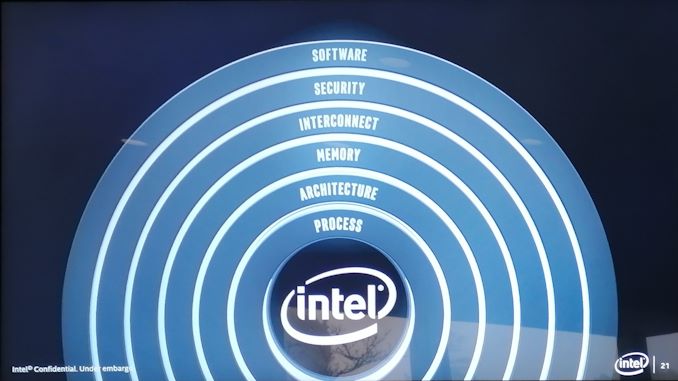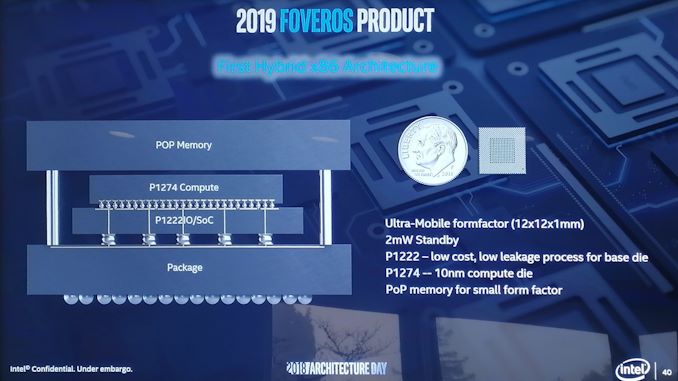Intel's Architecture Day 2018: The Future of Core, Intel GPUs, 10nm, and Hybrid x86
by Dr. Ian Cutress on December 12, 2018 9:00 AM EST- Posted in
- CPUs
- Memory
- Intel
- GPUs
- DRAM
- Architecture
- Microarchitecture
- Xe
Intel Made Something Really Funny
Q&A with Raja, Jim, and Murthy
Through Intel’s Architecture Day, the company did a couple of side discussions for a few journalists to speak to Raja Koduri and Jim Keller in a round-table format. Beyond that, Murthy Renduchintala and Raja also held a Q&A session at the end of the day. They answered questions on 10nm, the new Foveros technology, Thunderbolt 3 adoption, and how Intel will approach 5G.
For this article, the Questions and Answers will be listed as an abridged version of the responses, due to time constraints and live transcription, with questions grouped based on topic. Different members of the press asked these questions.
Q: A lot of the CPU microarchitecture at Intel has been hamstrung by delays on process node technology. What went wrong, and what steps have been made to make sure it doesn't happen again?
R/J: Our products will be decoupled from our transistor capability. We have incredible IP at Intel, but it was all sitting in the 10nm process node. If we had had it on 14nm then we would have better performance on 14nm. We have a new method inside the company to decouple IP from the process technology. You must remember that customers buy the product, not a transistor family. It’s the same transformation AMD had to go through to change the design methodology when they were struggling. At Apple it was called the ‘bus’ method.
M: This is a function of how we as a company used to think about process node technologies. It was a frame tick (limiting factor) for how the company moved forward. We've learned a lot about how this worked with 14nm. We now have to make sure that our IP is not node-locked. The ability to have portability of IP across multiple nodes is great for contingency planning. We will continue to take aggressive risks in our designs, but we also will have contingency. We need to have as much of a seamless roadmap as possible in case those contingencies are needed, and need to make sure they are executed on ASAP if needed to keep the customer expectations in line. You will see future node technologies, such as 10/7, have much more overlap than before to keep the designs fluid. Our product portfolio on 14nm could have been much better if our product designs were not node-locked to 10nm.
R: In the future there will be no transistor left behind, no customer left behind, and no IP left behind.
Q: Will we ever see a 10nm monolithic desktop CPU at the high end?
R: Yes.
Q: How is 10nm? Has it changed?
R: It is changing, but it hasn't changed. There are a lot of lessons learned in how Intel approached it to begin with. We are established a much better model between manufacturing and design. We want good abstractions in product and process node going forward. When everything was going well, this issue didn't manifest and so wasn't an issue. There's complexity here when something bad happens on process, so the whole pipeline clogs up - the rest of the world solves this with abstraction. We need to make sure it won't happen again, and we have a desire to build resilience in the roadmap.
Q: Are there plans for mixed SoCs, combining CPU / GPU / AI / FPGA ?
R: In our roadmap there will be scalable vector/matrix combinations. What our customers want are very scalable solutions. Customers want similar programming models regardless of the silicon.
Q: What has been the effect of hiring Raja/Jim and bringing outsiders to Intel?
M: Intel is very innovative. We want to add to that chemistry and make sure we bring in people who understand Intel but also bring in good ideas. It's about respecting the rest of the market and make sure Intel is competitive. It's balancing the centre of internal debates by making sure we are challenging internal beliefs and the status quo by bringing in people who have done this sort of thing before. It shows to Intel's strengths in its ability to absorb interesting ideas from the outside. We went for the very best on the outside because that was what required to join with the very best on inside.
Q: What is Intel’s current approach to 5G, given the topics discussed today?
M: We think about 5G from the datacentre to the network to the edge and to the device. We at Intel believe the transition to 5G and its implications on the network, in terms of accelerating data and catalysing a software defined network where bespoke silicon gets replaced by containers, is as transformative as the jump from analogue to digital. It will accelerate the ‘cloudification’ of the network. The edge is important, especially to minimize latency for new services. Sub-millisecond latency for these services is critical. The over-the-air interface is important too. The intelligent cloud domain is going to be the flywheel about how fast the industry evolves. We mentioned in November that our XMM 5G modem will be in the hands of partners in the second half of 2019 with products in early 2020. It is a multi-mode 5G LTE architecture from day one, supporting all 3 mmWave bands, and sub-6 GHz frequencies.
Q: As Thunderbolt 3 requires additional chips, how do you see future OEM adoption?
M: Integrated Type-C Thunderbolt 3 is the first generation. We will refine it in the future - that's the natural genealogy of the technology. We constantly think about how much we integrate into the chip and how much we leave on the board.
R: This is a big IP challenge, not only for TB3, but for other IP. Integrated PHYs are important. For example, by disaggregating the transceiver in our FPGA line-up, it has allowed us to focus on that decoupled IP a lot.
Q: In the demo of FOVEROS, the chip combined both big x86 cores built on the Core microarchitecture and the small x86 cores built on the Atom microarchitecture. Can we look forward to a future where the big and little cores have the same ISA?
R: We are working on that. Do they have to have the same ISA? Ronak and the team are looking at that. However I think our goal here is to keep the software as simple as possible for developers and customers. It's a challenge that our architects have taken up to ensure products like this enter the market smoothly. We’ll also have a packaging discussion next year on products like this. The chip you see today, while it was designed primarily for a particular customer to begin with, it’s not a custom product, and in that sense will be available to other OEMs.
M: We've made the first step on a journey. That first step is a leap, and the next step is incremental. As we've said about One API strategy – if we homogenise the API then it'll go into all our CPUs. FOVEROS is also a new part/product that shows that we had a gap in our portfolio – it has helped us create technologies to solve an issue and we expect to expand on this in the future with new IP.
Q: Are you having fun with FOVEROS?
J: Because Raja deals in GPUs, he’s having fun with high bandwidth communications between compute elements. It's a new technology and we're having some experimentation with it. What is frustrating is that as an industry we hit a limit for current flux density a year before stacking technology became viable, so for high performance on stacking we're trying a lot of things in different areas. There's no point having to make thermal setbacks if it also removes the reason why you're using the technology. But we're having fun and trying a lot, and we'll see FOVEROS in a number of parts over the next 5 years. We will find new solutions to problems we don't even know exist yet.
Q: When is Manufacturing Tech Day?
M: We will tell you when it happens! I'm sure you all have opinions on Intel 10nm right now and yes we are looking at what we're doing, eating an amount of humble pie, but we're re-adjusting our process to make sure that we can take the best process no matter what the product is.
The title of this page was a quote from Jim during the Q&A: 'At some point in the future you'll read an article with the title Intel Made Something Really Funny.'. I think I win this bet...

















148 Comments
View All Comments
CajunArson - Wednesday, December 12, 2018 - link
There's nothing whatsoever revolutionary about "chiplets". A 10 year old core 2 quad used exactly the same technology that AMD calls "chiplets" in 2019 and AMD fantards like you even insulted the Core 2 quad for doing it.Maybe you should actually read the article about what a active interposer can do vs. wiring standard hunks of silicon to a PCB in literally the same way it was done in the 1970s before you run around acting like AMD is the only company to ever innovate anything.
sgeocla - Wednesday, December 12, 2018 - link
I've been reading articles about Intel 10nm promises for years now. And then we got failed laptop chips and low power pc boxes to appease 'mass production' status and not get sued by investors for false claims.Forgive me if I abstain my drooling until Intel actually delivers something that does not require industrial chillers. BTY where is that 28 core HEDT chips anyway ?
Targon - Wednesday, December 12, 2018 - link
There is always a point where the WHEN something is used sets a new direction. Multi-CPU in a workstation/server moving to a single processor with multiple cores was a big shift. Moving from two cores linked together when cache coherency was a big problem to a single dual-core without an interposer was a better way to go. It all comes down to if there is a performance boost or degradation as a result of the technology/implementation.With that said, a single CPU with 64 cores is fairly significant, and keeping the performance from being horrible with that many cores is the reason AMD has been praised. Price/performance for the server market and such.
For a long time, Intel was seen as the king when it came to clock speeds and performance, but Intel hasn't had a significant boost to IPC in over three years. Intel has also been promising 10nm for three years, and still no sign of it, with the promise of holidays 2019.
So, Intel still has nothing, they have vague promises of ways they will improve performance, but it remains to be seen if the performance will actually be better if 10nm slips again. On the flip side, AMD clearly has significant performance boosts from Ryzen 3rd generation in 2019(March/April being when many expect it). 7nm from AMD isn't a, "will they?" question, it isn't even a "when?", with CES in one month and with it, the answers. IPC improvements due to design improvements not related to chiplets at all would be good, as well as higher clock speeds. So, there is a potential for 30+ percent higher performance in one generation.
Yes, I don't expect AMD to deliver huge performance jumps again for years, but we may see things such as Gen-Z support, going beyond two memory channels for the mainstream Ryzen chips when the next socket comes out in 2020/2021, and other things that may boost system/platform performance while AMD figures out how to get more CPU performance.
Intel is still trying to do things the same way, just faster. Faster CPU, faster links to individual devices, fabric on a system level will be Intel trying to reinvent what AMD has been working toward.
I will also note again that some things are not always about being new, but are more about presentation and implementation. Palm really popularized the idea of apps that users could install on a small portable device(PDA), but Apple popularized it with the iPhone. In some cases, the implementation really is good, and will get the respect of the industry, in other cases, you see that something is clearly a case of following the lead of another player.
So, in the PC industry, is Intel leading the way with innovations, or is AMD in the drivers seat?
iwod - Thursday, December 13, 2018 - link
No one insulted Core 2 Quad for doing it, and neither did AMD. But Intel did Insult AMD and went on full force bad mouthing AMD.Spunjji - Thursday, December 13, 2018 - link
Using a term like "fantard" straight-up devalues your argument, but the blatantly false statement about the C2Q using "exactly the same technology" seals the deal.Chiplets refers to the CPU being divided into multiple sections (cores and un-core) on a single package using dedicated interconnects. It's not at all the same technology as having two discrete CPUs joined by the FSB on a single package. Both are novel approaches to particular problems, although the C2Q (and Pentium D before it) were criticized for their inefficiency by using the FSB for inter-core communication. We don't know how "chiplets" will pan out yet, so the jury's out.
Bash the fans for talking nonsense all you want, but maybe don't sink to their level.
edzieba - Wednesday, December 12, 2018 - link
If you think through-package interconnects compare to through-silicon interconnects, then I have some HBM on DIMMs to sell you.Spunjji - Thursday, December 13, 2018 - link
Noice. :DIII-V - Wednesday, December 12, 2018 - link
I love how everyone thinks AMD is the pioneer with chiplets. They're not. That would be Marvell.And Intel themselves has been hinting that it's a good way to go, looking at their EMIB solution.
But AMD fan boys are a special breed of stupid...
sgeocla - Wednesday, December 12, 2018 - link
The electric car was pioneered more than a hundred years.It's one thing to pioneer something and a whole different thing to actually develop it into something that is affordable to millions and drags the whole industry forward.
If you think pioneering is all there is to it I have hundreds of grapehene battery designs you should invest you narrow-minded-driven life savings into.
evernessince - Wednesday, December 12, 2018 - link
You have some issues buddy. How about not being toxic next time.